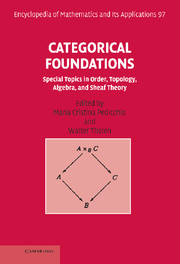Book contents
- Frontmatter
- Summary of Contents
- Preface
- Contents
- Introduction
- I Ordered Sets via Adjunction
- II Locales
- III A Functional Approach to General Topology
- IV Regular, Protomodular, and Abelian Categories
- V Aspects of Monads
- VI Algebraic Categories
- VII Sheaf Theory
- VIII Beyond Barr Exactness: Effective Descent Morphisms
- Index
Introduction
Published online by Cambridge University Press: 05 November 2013
- Frontmatter
- Summary of Contents
- Preface
- Contents
- Introduction
- I Ordered Sets via Adjunction
- II Locales
- III A Functional Approach to General Topology
- IV Regular, Protomodular, and Abelian Categories
- V Aspects of Monads
- VI Algebraic Categories
- VII Sheaf Theory
- VIII Beyond Barr Exactness: Effective Descent Morphisms
- Index
Summary
Following the many splendid mathematical discoveries of the nineteenth century, mathematicians like Felix Hausdorff and Emmy Noether formalized the key-notions and thereby the categories which enable us to pursue modern structural mathematics. Bourbaki's monumental work gives the most comprehensive testimony of this rapid development during the first half of the twentieth century. Despite the laudable trend toward emphasizing applications, for the past few decades there has been little change in the overall perception of which general notions are to be considered important, and they continue to dominate the standard courses on topology and algebra.
Soon after Samuel Eilenberg and Saunders Mac Lane coined the notions of category, functor and natural transformation in the 1940s, a very different way of doing structural mathematics emerged which was promoted especially in homo-logical algebra. Rather than building objects made up from sets with a structure, like topological spaces and modules over a ring, one imposes additional conditions on a category which make its objects behave like the structured sets one has in mind. Hence, rather than relying on a set-theoretic foundation on which to build the structures at issue, one moves into a “fully equipped building” in which to explore the objects of interest. Indeed, the category theory of the 1950s, especially Alexander Grothendieck's work, showed that a great deal of module theory can be performed in any abelian category and which abelian categories are actually-equivalent to module categories.
Information
- Type
- Chapter
- Information
- Categorical FoundationsSpecial Topics in Order, Topology, Algebra, and Sheaf Theory, pp. 1 - 4Publisher: Cambridge University PressPrint publication year: 2003
